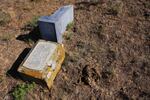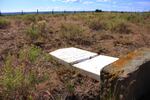
Many rural counties contain a number of remote, sagebrush cemeteries that are unmanaged. It's common for cows to break through fences to eat grass in the cemetery. Sometimes, tombstones become bovine. scratching posts.
Amanda Peacher / OPB
You've heard of cow tipping. How about tombstone tipping? Where the offenders are cows?
Every year during the summer grazing season, rural Oregon counties deal with a unique challenge: Cows break into old, remote cemeteries.
"Eventually you got this acre that is fenced off, and it's got tall green grass on it," explained Harney County Judge Steve Grasty. "And all the rest of it has been eaten down. Are [cattle] going to push the fence in on it? Yes. Are they going to get in? Pretty common."
Grasty is searching for means to repair cow wreckage at a cemetery that a herd got into earlier this season near Riley, Oregon.
The hungry cows knocked over tombstones, leaving them cracked or shattered.
"They always want to rub on stuff to scratch themselves. So, over they go," said Grasty.
Sometimes, cows also get access because visitors leave a gate open. In rural Harney County, many of the tombstones are more than 100 years old, and bear names of early white settlers and ranchers.
Grasty estimates that there are 25 tiny, old cemeteries in Harney County alone. Old tombstones sit among sagebrush and — if they've been grazed recently — cow pies. Often, the remote cemeteries are barely accessible by road.
Grasty said there's a report of cow damage in at least one cemetery every year.
Often, it's a challenge to figure out who owns the land housing these rural cemeteries, much less find someone who could be held responsible for repairs.
"Somebody will go out and repair things," said Grasty. "Might be me helping them on a weekend, I don't know."


